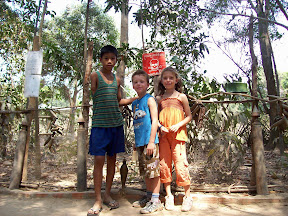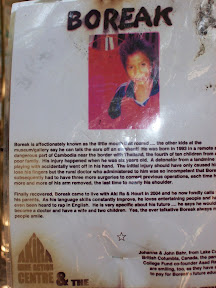The Legend of Aki Ra
For us, one of the highlights of our visit to Siem Reap had nothing to do with temples. I had read about a small private museum just outside Siem Reap, called the Cambodian Landmine Museum, not to be confused with the government-run War Museum. Once we had seen our fill of temples, I asked our driver if he could take us there and, after conferring with another driver to get directions, he agreed. He took us off the main road onto a bumpy dirt road that wound through a dusty little Cambodian village for about 10 minutes before stopping at the side of the road next to a gate formed by two mortar shells with a sign suspended between them that read, “Landmine Museum.”

As soon as we entered the gates, a young boy with only one arm approached us and asked us if we would like a tour. After our experiences at the temples, my first reaction was, “How much?” However, the boy just smiled and said, “Just a donation to the museum – whatever you like.” After I smiled sheepishly and accepted his offer, he introduced himself as Boreak and told us his story.


Born in a dangerous, remote part of Cambodia near the Thai border, he had lost his hand at the age of six when a land mine detonator he was playing with exploded in his hand. Due to the lack of adequate medical care, he eventually lost his entire arm after four successive operations. Unable to care for him, his parents begged Aki Ra to take care of their son and he went to live with the other landmine victims at the Cambodian Landmine Museum. Boreak spoke proudly of Aki Ra and said that he now considers him to be his father.
So who is this legendary Aki Ra? Born in the early 70’s, he was only a few years old when the Khmer Rouge took over his village and soon killed both his parents. Aki was “adopted” by the Khmer Rouge and was raised as a child soldier. He was taught to build bombs, lay landmines and had his first gun by the age of ten. He was 13 when the Vietnamese liberated his village and conscripted him into the Vietnamese army to fight against his friends in the Khmer Rouge. Finally, when the Vietnamese army withdrew from Cambodia in 1990, Aki Ra was released into the Cambodian Army and was finally able to go to school and receive and an education. Once his education was complete, Aki Ra became very focused on saving his country and set about doing this the only way he knew how – by removing the dangerous landmines that he had helped to put in the ground. Armed with a metal detector, a pen knife and his knowledge of ordnance, he worked first with the UN and then independently to clear land mines across Cambodia, including around Siem Reap and the temples of Angkor. Over the years, he has taught 100’s of Cambodians, including his wife, how to clear landmines and has been personally responsible for removing over 10,000 landmines. Despite his legendary status, Aki Ra operates without government funding and his organization, the Cambodian Landmine Museum, is financed completely by donations. After collecting and disarming thousands of different landmines, unexploded ordnance (UXO) and artillery, Aki Ra decided to create the Landmine Museum to educate the public about the 3 to 6 million landmines and other UXO that remain in the ground in Cambodia, which holds the dubious title of having the most landmines per square metre in the world. A few years ago, he was almost shut down when the Cambodian government accused him of keeping dangerous live ordnance at the museum and confiscated his artifacts in order to use them in their newly created War Museum. Fortunately, Aki Ra was able to make peace with the government and, due to his constant clearing of landmines, quickly acquired plenty of new displays for his museum.
The most compelling part of Aki Ra’s story, though, is his devotion to the Cambodian people, especially to the victims of landmines and war. He and his wife have adopted over 20 children who have been maimed by landmines and brought them to live with them in Siem Reap. They are ensuring that these children, many of whom had been begging on the street, are being loved, fed and clothed and are receiving an education. Our eyes filled with tears as we met these children and heard their stories, but our hearts lifted when we saw their happy smiles and heard the joy in their voices as they spoke of their “father,” Aki Ra. These kids truly are the lucky ones because, not only have they been rescued by Aki Ra, but their futures are also secure, since each child has had a Western visitor volunteer to fund their university education. I say they are the lucky ones because they represent less than 0.1% of the more than 27,000 landmine victims in the Siem Reap province of Cambodia alone. That figure is still rising because, at the current rate, it will take 50 to 100 years to find and clear every landmine.
It is a true testament to his strength of character that Aki Ra was able to survive the brainwashing of the Khmer Rouge, being taught to kill from very young age, and emerge with his conscience and sense of right and wrong intact. The fact that he continues to persevere, without government funding, to rid his country of the scourge of landmines, demonstrates his commitment and determination to single-handedly right the wrongs committed by the Khmer Rouge so many years ago. If only we could all be so selfless and altruistic, the world would be a much better place. If you have been as moved by Aki Ra’s story as I was and would like to help, there is a way. It costs between $20 to $50 per day to clear mines and, on average, $2 will clear three mines. For more information about Aki Ra, the Landmine Museum and how to make a donation, visit his website at www.cambodialandminemuseum.org .
Tags: Cambodia, Siem Reap, South East Asia, Travel

Boreak’s and Aki Ra’s story have been documented (with sympathy but never condescension) in a new film called Aki Ra’s Boys.
http://www.filmfest.org.sg/displayfilm.php?filmid=010
My review: http://budak.blogs.com/the_annotated_budak/2007/04/drinking_origin.html#comments